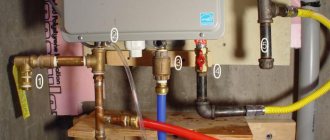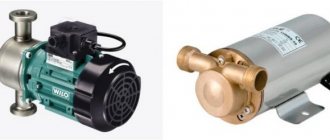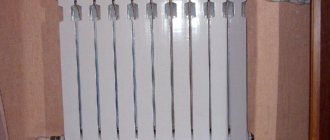The reasons for the increase in pressure. Ways to solve the problem
To understand that there is too much pressure in the system, you can use the pressure gauges. Normally, the readings are 1-2.5 bar. If the pressure gauge needle reaches 3 Bars, sound the alarm. If the increase is constant, it is urgent to find the cause and reduce the pressure.
Also pay attention to the safety valve: to relieve pressure, it will constantly exude water
The case in the expansion tank
This tank can be located separately from the boiler or be part of the structure. Its function is to draw in excess water when heated. The hot liquid expands, it becomes 4% more. This surplus is sent to the expansion tank.
The size of the tank is influenced by the power of the boiler. For gas equipment, its volume is 10% of the total amount of the coolant. For solid fuel - 20%.
Diaphragm rupture. If the part is damaged, the coolant is not restrained by anything, therefore, it completely fills the expansion tank. Then the pressure starts to fall. If you decide to turn on the tap to add water to the system, the head will rise above normal. Leaks will appear in the connections.
Replacement of tank or diaphragm is required to relieve pressure.
Pressure below or above normal. A machine pump will help to achieve normal values (nominal) in a gas boiler.
- Drain all water from the system.
- Close the valves.
- Pump the circuit until you are sure there is no water.
- How to release the air? Through the nipple on the other side of the inlet.
- Download again until the indicators reach the norm specified in the instructions for "Ariston", "Beretta", "Navien" and other brands.
The location of the tank after the pump provokes water hammer. It's about how the pump works. When it starts, the head rises sharply, and then also drops. To avoid such problems, in a closed heating system, install the tank on the return pipe. The next pump cuts in front of the boiler.
Why the pressure rises in closed systems
Air accumulates in a double-circuit boiler. Why does this happen:
- Incorrect filling with water. The fence is drawn from above, too fast.
- After the repair work, the excess air was not deflated.
- Mayevsky's air release taps are broken.
The pump impeller is worn out. Adjust or replace part.
Fill fluid correctly to relieve or reduce pressure. The intake is carried out from below, slowly, while Mayevsky's taps are open to bleed off excess air.
Open system problems
The problems are the same as described above.
It is important to properly fill in water and bleed air. If after this the pressure has not returned to normal, it is necessary to drain the system.
Secondary heat exchanger
The unit is used to heat hot water. Its design consists of two insulated tubes. Cold water flows through one, hot water through the other. In case of damage to the walls, the appearance of a fistula, the fluids mix and enter the heating part. Then there is an increase in pressure.
If you do not want to repair and solder the heat exchanger, you can replace it. To do this, buy a repair kit and get to work:
- Close the supply valves.
- Drain the water.
- Open the case, find the radiator.
The assembly is secured with two bolts. Unscrew them.
- Dismantle the defective part.
- Install new gaskets in the mountings and connect the heat exchanger.
Other reasons
There are other reasons for these problems:
- Overlapped fittings. During the intake, the pressure rises, the safety sensors block the equipment. Inspect the taps and valves, unscrew them all the way.Make sure the valves are working.
- Clogged mesh filter. It gets clogged with debris, rust, dirt. Remove and clean the part. If you don't feel like cleaning regularly, install a magnetic filter or a flush filter.
- The make-up valve is out of order. Perhaps its gaskets have worn out, then you can get by with a replacement. Otherwise, you will have to change the tap.
- Problems with automation. Faulty thermostat or controller. The reason is wear, factory defect, incorrect connection. Diagnostics and repairs are carried out.
Check whether the boiler protection parts are in good working order: pressure gauge, valve, air vent. Clean radiators and other components from dust, soot, scale. Prevention helps prevent serious damage to gas equipment.
Pressure increase due to expansion tank
Reasons for an increase in pressure in the heating circuit due to problems with the expansion tank:
- Small volume of the expansion tank. When heated to 85-90 ° C, water adds about 4% in volume. If a small tank is selected, then the coolant expands when heated and fills the container. There is a complete discharge of air through the valve. With further heating, the tank can no longer compensate for the thermal increase in the volume of water, as a result, the pressure in the system rises. The volume of the expansion tank must be at least 10% of the total volume of the coolant in the circuit if a gas boiler is installed, and at least 20% if the boiler is solid fuel. The volume of the tank can be taken approximately - according to the power of the boiler: for 1 kW there is about 15 liters of water. But it is better to calculate the volume of a single circuit (by heating surfaces);
- Damage to the rubber membrane of the tank. In this case, the water will completely fill the container, and the pressure gauge will show the drop in pressure in the system. But, if you open the make-up valve and add water, then when the coolant heats up, the pressure in the heating circuit will become much higher than the operating pressure. To solve the problem, you will need to replace the tank if the membrane is of the diaphragm type, or replace the membrane if it is of the balloon type;
- The pressure in the expansion vessel is too high or too low. Expansion vessel malfunctions are one of the main causes of pressure build-up in a closed system. You can check the pressure and pump it up, if necessary, with an ordinary car pump. Before checking, you need to drain the water from the heating system - the arrow of the system pressure gauge should be at zero. If there are shut-off valves and a drainage drain on the water pipeline to the expansion tank, then it is enough to drain the water only from the tank. Then, air is released through the nipple, which is located on the side opposite to the water supply. If the boiler is operating at a pressure of 2 bar, the pressure gauge on the pump should show 1.6 bar. It is necessary to open the water shut-off valve and add the volume of water drained from the expansion tank through the make-up tap. This adjustment method works for both bottom and top water tanks;
- The tank is located immediately after the circulation pump. This leads to the fact that the pressure rises sharply, and its release occurs almost immediately, while pressure surges are observed. This situation can provoke water hammer in the circuit. To solve this problem, in a closed heating circuit, an expansion tank is installed on the return pipe - in the laminar flow zone with a minimum coolant temperature. The pump cuts into the return line after the tank, in front of the boiler.
Pressure drop
An increase in pressure in closed heating systems is not the only problem, in some cases there is a sharp drop in operating pressure, while among the reasons why the pressure level drops, the following should be highlighted:
- hidden leaks of the system, the appearance of corrosion, loosening of connections, leaks of fittings;
- rupture of the tank membrane, which requires replacement or repair of equipment;
- pressure drops in the system are observed if the nipple is poisoned, such an air leakage leads to a deflation of the tank, and this causes damage to the membrane;
- there are cracks on the boiler heat exchanger, which leads to a coolant leak;
- pressure drops associated with the appearance of air bubbles lead to a decrease in the overall temperature in the system and its shutdown;
- one of the reasons for a decrease in pressure can be a sour or slightly open tap used to discharge water into the sewer system.
Preventive work
Keep an eye on the serviceability of the pressure gauge, air vent and safety valve, it is these devices that are used to protect your unit from high pressure.

Safety group for heating system
The addition of antifreeze to the coolant in models where this is not prohibited by the manufacturer will reduce filter clogging, sticking of protective valve elements, and reduce the formation of scale on air vents.
Flush the heat exchanger regularly, this will prolong its life, prevent the formation of fistulas and scale.
We offer you to watch a video with answers to questions about increasing pressure in the heating system:
2017-06-14 Evgeny Fomenko
How to increase the pressure in the boiler


If the pressure drops due to the expansion tank, then its volume is incorrectly calculated or the inner diaphragm is damaged. The situation is corrected by a more accurate calculation of the required volume or by replacing the tank.
If the pressure in the heating system drops immediately after its first start, then this is the norm. The freshly filled circuit, if filled with ordinary tap water, is full of air. As soon as it is converted to bubbles and removed from the pipes, the parameters of the contour are normalized. You can also try to remove the bubbles by hand using a manual air release.
Worst of all, if the pressure has dropped in the system laid inside the walls and floors - pipes are often masked and completely recessed in building structures. If something happens to them, you will have to thoroughly suffer in order to localize the malfunction. The situation can be prevented by a more careful choice of materials for building a heating circuit.
Before raising the pressure, it is necessary to check the tightness of the system. To do this, you need to inspect:
- All heating devices - often leaks form where they connect to pipes. Leaks between individual sections are also possible;
- Pipes - microcracks often lead to leakage of the coolant, due to which the pressure gradually drops;
- Fittings are another common place for coolant leaks;
- Boilers - double-circuit models have a complex internal structure; it is necessary to inspect the circulation pump, three-way valve and heat exchanger.
It is best if a specialist takes over the inspection of the double-circuit boiler.
Increased pressure in the heating system causes an imbalance in the operation of the equipment, frequent blockages of the boiler. As a result, individual elements are subjected to increased stress, which leads to circuit breakdowns and equipment failure. Why is the pressure in the heating system increasing? There are several reasons for this phenomenon, most often these are leaks, imbalance in the operation of individual elements, a malfunction in the automation or incorrect settings.
Other causes of high blood pressure
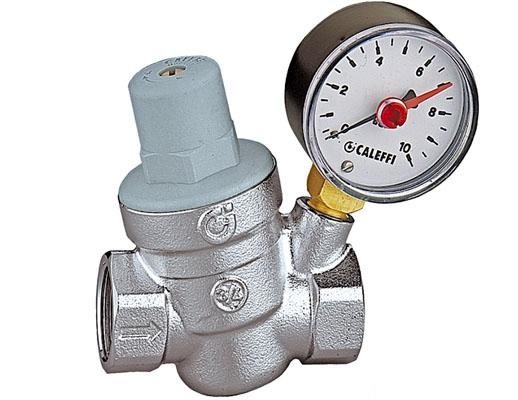

An increase in pressure in the heating system is also possible due to the fact that:
- Stop valves are partially or completely blocked. As a result, the water supply pressure rises sharply and the boiler is blocked. It is necessary to open the stopcocks and valves, check the heating fittings for leaks;
- If a mechanical mud filter is installed, then its mesh can be clogged with particles of rust, slag or sand. As a result, the pressure rises in the section "boiler - filter". Flushing the filters will help to relieve the pressure of the coolant. The simplest corner filter should be washed at least 3-4 times a year. Washing and magnetic filters are more expensive, but such devices purify water better and require cleaning only once a year;
- Leaks or does not "hold" the make-up water tap. The pressure in the water supply network is in the range of 2.5 - 3.5 bar, that is, water will flow into the heating system, where the pressure is lower. This will inevitably lead to an increase in the volume of the coolant. To solve the problem, you need to turn off or replace the make-up water tap. Most often, rubber gaskets become unusable and require replacement. As a temporary solution to the problem before replacing the deteriorated parts, you can reset the indicators by completely shutting off the water supply to the double-circuit boiler;
- Failure of the boiler automation, failure of the thermostat or controllers. It is not always possible to establish why this is happening. The reason may be a factory defect, the use of substandard materials in the manufacture of the control board, improper installation, etc. You can fix the problem yourself, knowing the error code and having the technical passport of the device. If the technical passport does not contain an error code and a way to eliminate it, you cannot do without a service department.
Norm and control
We have already said that the pressure in a gas boiler should be in the range of 1.5-2 atmospheres - this is the norm for a system that is put into operation and is in a heated state. In multi-storey buildings heated by centralized boiler houses, this figure is higher. Here, pipes and batteries must withstand not only high pressure, but also water hammer - this is an abrupt increase in pressure.
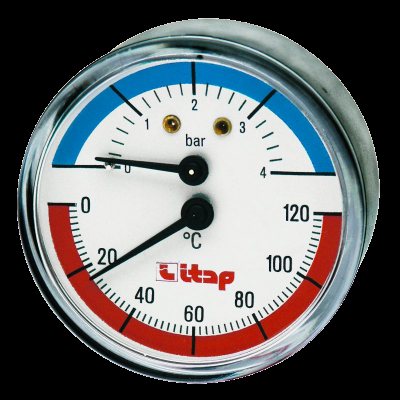

If drops are typical for centralized systems, then for autonomous heating they are rare - the volume of the coolant here is not so large that serious jumps are observed. In a cold state, the normal indicator is 1-1.2 atm., And in a heated state, a little higher.
In private households, autonomous heating systems are used, powered by single-circuit and double-circuit boilers. The latter are becoming more widespread. In addition to heating, they solve the problem of preparing hot water. One circuit in them heats the coolant circulating through the pipes, and the other ensures the operation of the hot water supply system.
If there is no expansion tank
The expansion tank for the domestic heating network is the second most important element (after the boiler). Water, with a change in temperature, changes in volume. The volume inside the circuit is always constant, therefore, an expansion tank is additionally connected to the circuit, where excess coolant can be diverted, i.e. performs the function of a compensator. Consequently, RB is a safety device that prevents emergency situations - an increase in pressure, depressurization of pipes, etc.
The use of boiler equipment without an expansion tank is highly discouraged.
For stable operation, the pressure of the RB must correspond to the volume of the system, since when replacing radiators with pipes, the volume of the coolant must be increased. At the same time, too large RB will not maintain the operating pressure in the circuit.
The standard is an expansion tank, designed for 120 liters of heating medium in the circuit (typical two-room apartment). If the tank is too small, then the water will be discharged during heating and expansion through the safety valve. When the boiler is turned off, when the liquid temperature decreases, the boiler will not start up, because its volume, and, therefore, the head will be insufficient. In such cases, additional power supply is required.
https://youtube.com/watch?v=tgwLKEVRgYk%3F
Best Answers
amateur:
You must have a vent, an air vent. Put a hose on it so as not to get wet, and quietly opening the tap - try to relieve the pressure. (this is my opinion, but it is better to call a specialist.)
Boss Heat:
In any place of the heating system where there is a drain tap (Mayevsky tap, battery drain, etc.), open it and pour it into a jar or bucket. It is most convenient to turn the relief valve on a wall-mounted boiler.
Eliseikin:
Look for the drain valve .. must be!
alexm66:
The boiler has a drain valve (usually at the bottom). It usually opens with a key - there is no flywheel on it. The instructions for the boiler indicate its location. In this case, it is advisable to stop the boiler.
So I say:
Before releasing the pressure, check the opening of the valve on the expansion vessel. If closed, open, the pressure should drop. If it was opened, bleed off the battery in any convenient place. In no case do not relieve the pressure from the boiler safety group yourself - if a speck gets under the valve seat, it can be very difficult to wash it off, so the valve drips.
Victor:
Put on the expansion tank and forget about pressure surges.
L @ rchik:
Bleed air from the radiators, the pressure will immediately drop. Do not go into the well-oiled mechanism (boiler).
What can jams in the circuit lead to?
The importance of air ducts cannot be overstated. Traffic jams in the circuit can lead to different processes:
- violation of circulation;
- pressure surges;
- decrease in the efficiency of heating equipment;
- corrosion of metal.
Stand-alone air vent
Installing an air vent in the heating system prevents the formation of plugs and pockets. Bumping into them, the coolant stops. Sometimes plugs cut off whole sections with radiators from the circuit. In this case, the pressure in the system increases. When it reaches a critical level, an emergency release of the coolant occurs. This, in turn, leads to a drop in pressure. At the same time, there are many cases when air was collected in the batteries, the circuit continued to work, only half of the radiator becomes cold. This significantly reduces the efficiency of heating and slightly increases the cost of its operation.
One of the greatest threats to open systems is rust. At the same time, the question of how to remove air from the heating system arises only at the design stage. Such circuits are assembled at an angle from pipes with a large diameter, respectively, there is a lot of water in the system. Considering the fact that the coolant is in contact with air and draws it into circulation, the oxygen level in the pipes is more than sufficient. Since it takes a long time to discharge air from the heating system, oxygen intensively reacts with the metal. The result of the interaction is the formation of corrosion on the inner walls of the pipes. Rust sometimes eats up the tank so much that you have to change it.
Direct consequences of traffic jams in the circuit entail indirect ones, which are no less dangerous:
Occurs when the valve for bleeding air from the heating system and all sensors are in good order and work correctly. Due to an increase in pressure, an emergency release of the coolant occurs, which leads to a decrease in its amount in the circuit. After cooling down, there will be not enough fluid in the system, the pressure will drop sharply. If it does not correspond to the minimum required to turn on the boiler, the heater will not turn on accordingly. And from this moment in winter, the countdown begins when the pipes will defrost. Depends on how insulated the house is. It happens that this happens in just three hours. In this case, unpleasant news awaits at home from work;
This happens if a malfunction occurs in the valve for bleeding air from the heating system, or temperature control equipment. Unlikely situation, although possible. The results are very disastrous. At best, boiler repair or replacement, at worst - injury;
rupture of the circuit and ejection of a hot water fountain.
A very likely situation, the joints may not be tight enough. With increasing pressure, they do not withstand and crack. At the same time, a hot coolant flows from the pipe, like a fountain. Not only does the circuit need to be repaired, so also the neighbors do the ceiling, since you filled it in order. This is the chain that simple airing of the system can cause.
The pressure in the heating system in the wall-mounted boiler rises
The presence of a stable operating pressure in the heating system (1 - 2 bar) is a guarantee of the safe operation of a double-circuit gas boiler. The boiler will not start if the system pressure is less than 0.6 bar, if more than 3 bar, an emergency water discharge occurs.
- There are two reasons why the pressure in a double-circuit gas boiler can gradually, but constantly increase:
- does not hold the make-up tap (most likely);
- secondary heat exchanger defective.
This usually happens like this: the pressure rises slowly (sometimes you may not notice it and leave for several days) until the safety valve is triggered (usually at 3 bar). And so several times, in a cycle. As a result, the floor in the kitchen is flooded, furniture and mood are ruined.
The heating system is autonomous (not connected to the water supply). It is essentially a closed circuit that can be heated by a gas burner. But to fill this heating circuit with water, there is a make-up tap, and if it leaks, then water from the water supply system will leak into the heating system (increasing the pressure there).
Well, the second (unlikely) option - in the secondary heat exchanger, the water supply and heating pipes are located side by side, literally through a thin wall. And if a fistula has formed there, then leakage from the water supply system to the heating system is possible (until the pressure is equalized). And if the pressure in the cold water supply is more than 3 bar, the same pressure will eventually be in the heating system. Which will trigger the emergency valve (and discharge some of the water).
How to fill the heating system of a double-circuit boiler
- The heating system of a double-circuit gas boiler is filled through the make-up valve, which is included in the basic configuration of any boiler:
- we open all air vents;
- open the make-up tap and fill the system;
- as the circuit fills, close the air vents;
- we achieve the pressure (specified in the boiler passport);
- after the pressure in the heating system has reached the required level, the make-up valve is closed.
What is a make-up tap on a gas boiler for?
The make-up valve serves for the primary filling of the heating circuit with a heat carrier (water) and compensation for the loss of the heat carrier.
- But the loss of the coolant itself is possible for several reasons:
- commonplace coolant leaks at the joints of pipes and radiators;
- in case of critical exceeding of the modes, an increase in pressure in the heating system may occur, which leads to the operation of the emergency valve, which discharges part of the coolant;
- automatic air vents release air, but a little of the coolant still comes out in the form of steam.
Boiler feed valve how it works
The filling and make-up valve of compact boilers is usually located at the bottom of the body, next to the cold water supply pipe. And it is a manual valve that connects this line to the heating return line.
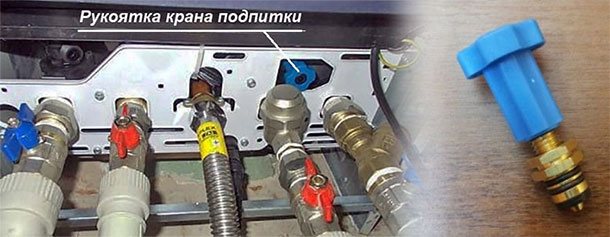

The double-circuit gas boiler does not hold the make-up valve
- There are only two reasons why the make-up tap may not hold (undercut):
- from time to time the sealing gum on the rod has become stiff;
- the rubber band is torn, for example from overtightening the make-up valve.
How to properly tighten the make-up valve: select the free stroke of the stem (the valve rotates with almost no effort) and when you feel that the rubber band rested against the cone, tighten it another half turn.
Repair of the boiler feed valve
In most cases, it is not at all necessary to change the make-up tap, it is enough to release the water pressure in the boiler through the valve, unscrew the spinner from the tap and replace the small rubber ring on it.
Optimal value for a private house or cottage
Any boiler works with certain system settings, in particular, it is necessary to correctly calculate the water pressure. This value is influenced by the number of storeys in the building, the type of system, the number of radiators and the total length of the pipes. Typically, for a private house, the pressure level is 1.5-2 atm, but for a multi-apartment five-story house, this value is 2-4 atm, and for a ten-story house - 5-7 atm. For higher buildings, the pressure level is 7-10 atm, the maximum value is reached in heating mains, here it is equal to 12 atm.
For radiators that operate at different heights and at a fairly decent distance from the boiler, constant pressure adjustment is required. At the same time, special regulators are used to reduce, and pumps are used to increase. But the regulator must always be in good order, otherwise sharp fluctuations and drops in the temperature of the coolant will be observed in some areas. The system must be adjusted so that the shut-off valves are never completely closed.
Control devices
To control the water pressure in the heating boiler and heating system, manometers and thermomanometers are used. The latter are combined devices for monitoring two parameters at once. After starting the circuit, it is necessary to control the indicators so that they do not go beyond the normal range.
In some double-circuit floor and wall boilers, traditional dial gauges are absent. Instead of them, electronic sensors are installed here, information from which is transmitted to the electronic unit, after which it is processed and displayed. Another approach is also possible - if the heating unit is devoid of a pressure gauge, it is provided by the safety group.
The security group itself includes the following nodes:
- Manometer or thermomanometer - to control the temperature and pressure in the heating circuit;
- Automatic air vent - prevents contour airing;
- Safety valve - relieves the coolant pressure when it rises excessively.
Be sure to provide this unit in a closed heating system.
Gas boiler pressure control
All modern heating equipment is equipped with control sensors. The pressure sensor monitors normal operation. In the event of a deviation from the norm, it sends a signal to the control module, which causes the boiler to be blocked. Additionally, an error code may appear on the display.
How much pressure should be? A pressure gauge helps to track the values. Attached unit "Bosch", "Ariston", "Navien", Baxi, installed in the house, maintains values from 1.5 to 2 atm. The drop in indicators is observed only in systems with forced fluid movement (pump).
How the equipment works
Under normal conditions, work takes place in this way:
- Sensors record the temperature of the coolant. If an external thermostat is installed, the burner will automatically ignite and heat up.
- As the temperature rises, the pressure rises. When heated, the water expands, therefore, an expansion tank is provided to discharge excess coolant. The safety valve also discharges the surplus into the drain.
- If the operation fails, too much water is drained off. As a result, the pressure drops.
- As soon as the temperature reaches the set one, the boiler shuts down.
More about the operation of the expansion tank:
- The tank consists of two parts, which are divided by a diaphragm. In one cavity there is nitrogen, in the other excess liquid accumulates.
- The coolant fills it as much as the difference in the values of the system and nitrogen is great.
- As soon as heating stops, nitrogen pushes water out of the cavity by deforming the membrane.
How to bleed air from the boiler
Modern heat sources are equipped with automatic air vents or Mayevsky taps located in the upper part of the unit. Such a constructive solution allows air to be vented during operating mode without stopping the heating process of the room, just like from any radiator on which a similar valve is installed.
To do this, periodically open and close Mayevsky's tap, at intervals of several minutes. The procedure is repeated until a hiss or whistle appears, indicating the release of an airlock. The appearance of sound requires holding the bleed device in the open position until the coolant appears.
The lack of special devices for eliminating plugs on the boiler requires resorting to the help of the same devices on pipelines located above the heat source.
The ideal conditions for freeing from the air lock in the boiler is the possibility of a separate shut-off of the heat source circuit with a return pipe and a circulation pump. When turned on, the pumping of the coolant is ensured, and periodic opening of the Mayevsky valve or control over the operation of the automatic air vent, by pressing the spool, allows the closed circuit to be released from the plug.
If there is no circulation pump in the closed circuit, which cuts off the boiler with a return pipeline, then the energy source is turned on: gas, electricity, and in the solid fuel, the furnace is ignited. After heating the "supply" pipeline, the air release device is periodically opened. The heat carrier, when heated, will rise from the boiler along the main line due to heating and return through the connecting pipeline - back to the heat exchanger. This technique requires careful temperature monitoring, especially when servicing a non-solid fuel heat source. The movement of the coolant along such a circuit will be very slow and this is taken into account when performing work.
If it is not possible to shut off the boiler water circuit and there are devices for venting air only in the upper part of the line, it is necessary to drain the coolant, and then fill in the entire required volume of water. Before embarking on such global events, it is recommended to cut off all devices (except for the boiler) and, by turning on the pump, release the pressure through the nearest air vent on the line until sound or bubbles appear. The lack of a result indicates the need for complete drainage of the coolant.


